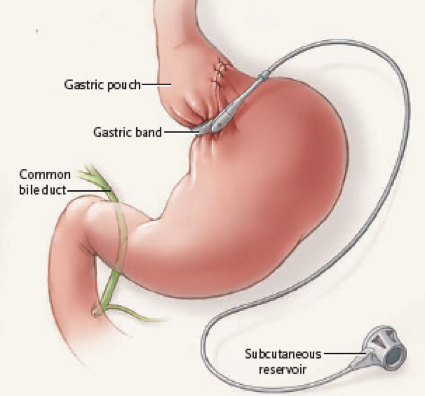What to Expect with Laparoscopic Adjustable Gastric Banding
People considering laparoscopic adjustable gastric banding are encouraged to
speak with others who have undergone the same procedure to better understand
the benefits and long-term lifestyle changes that must be made. Patients
are also encouraged to attend a monthly
support
group before and after surgery.
Preparing for the surgery
Prior
to the procedure, patients will:
- Meet with our
bariatric specialists to discuss pre- and post-operative details
- Meet with a
psychologist for an evaluation and testing to prepare for the diet
and exercise requirements that are essential to successful weight-loss management
- Be required for two
weeks before surgery to drink only high-protein shakes and eat one
sensible meal daily
- Be on a liquid diet
the day before surgery, drinking only high-protein shakes and zero-calorie
beverages
- Be encouraged to
exercise in the weeks leading up to the procedure
It’s essential to carefully follow diet and exercise
guidelines before surgery and to prepare for a regimented diet after surgery. Our
registered dietitians work with patients to develop individual meal
plans and fitness goals before and after surgery.
About the
surgery
A bariatric surgeon performs laparoscopic adjustable gastric banding by making
five or six small abdominal incisions and inserting a tiny camera and long
instruments through the incisions.
The surgeon places a band around the upper part of the stomach,
separating it from the lower part. This creates a small pouch with a narrow opening
that goes into the larger, bottom portion of the stomach.
The surgery does not require any cutting or stapling inside the
abdomen. Many gastric-banding surgeries take less than an hour.
Recovery
Patients
who undergo laparoscopic adjustable gastric banding usually spend one night in
the hospital after the band is placed. Depending on their condition and medical
history, most people can return to work within one to two weeks.
Life After Surgery
Post-operative
diet
As with all types of bariatric surgery, patients must immediately follow a
special diet for the rest of their lives after undergoing laparoscopic adjustable
gastric banding.
After the surgery, patients must eat
smaller portions and chew each bite more than 20 times before swallowing. Patients
with a LAP-BAND who eat too much or too fast will vomit, which can damage the
stomach and esophagus.
It generally takes six weeks after the procedure to “retrain”
the stomach to eat. The first two weeks consist of consuming only liquids.
During a six-week transition period, foods are gradually reintroduced to the
altered “new” stomach and remaining gastrointestinal system. Our
bariatric surgery team supervises this process.
Post-operative
exercise
As soon as the bariatric surgeon says it’s time, patients can begin a rigorous
exercise program to help them lose weight and avoid regaining it. Data shows
that exercise helps patients lose more weight more quickly while increasing
their aerobic fitness.
We recommend 150 minutes of moderate physical activity (such
as brisk walking) or 75 minutes of vigorous physical activity (such as jogging
or swimming laps) per week.
Post-operative
care
All
bariatric surgery patients are required to have regular follow-up appointments.
These visits ensure that weight loss occurs in a healthy, consistent manner and
help prevent minor complications from turning into major ones. The bariatric
surgery team will also regularly monitor patients’ vitamin and mineral levels.
Most patients who have had laparoscopic adjustable gastric
banding have their bands adjusted every eight weeks during the first post-surgical
year, then twice yearly during the second year, then annually.
At follow-up appointments, patients also may meet with a
registered dietitian, a bariatric advanced practice provider, or a bariatric
surgeon.
It can take two to five years for
patients to reach their desired weight after a LAP-BAND placement.






